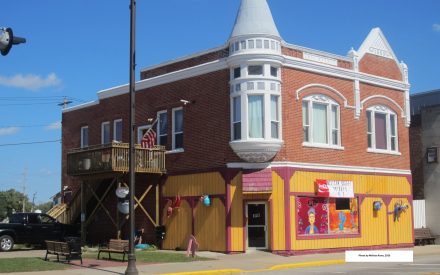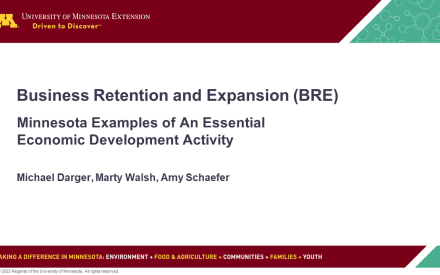
May 2022 — This section explains how market analysis data can be used in the various steps of a business recruitment program.
Communities can influence business investment decisions by drawing attention to local market characteristics that might otherwise be overlooked. A business recruitment team can identify high potential business sectors, compiling information of interest to business prospects, and marketing to those prospects. The key is to demonstrate that the community is a profitable place to do business. This is done on continuous basis covering a variety of business categories.
Market analysis data can be used in the following steps of a business recruitment effort.
- Step 1: Form a Business Recruitment Team
- Step 2: Create a Supportive Business Environment
- Step 3: Assemble Recruitment and Marketing Materials
- Step 4: Design an Ideal Tenant Mix
- Step 5: Identify Prospective Tenants
- Step 6: Contact Prospective Tenants
- Step 7: Close Deals with Prospects
- Step 8: Maximize Your Success
Step 1: Form a Business Recruitment Team
The founding members of this team are important for establishing the enthusiasm, momentum, professionalism and organization that will be needed. They need to be problem solvers and advocates for downtowns. This team and the recruitment process need effective and enthusiastic leadership to stay on track and be organized. Funding and in-kind services will be important to this committee.
Select the Team
To begin the recruitment process, a proactive business recruitment team needs to be assembled. This team should bring a clear and realistic understanding of the market analysis, have skills in economic development and real estate along with connections to local decision-makers, and have an ability to sell and follow through. Training for the team may be necessary. A team of five to seven participants could include:
- Established (and retired) business owners;
- Local real estate professionals;
- Current building owners who are interested in exploring various uses for their property;
- Bankers;
- Local entrepreneurship and development organization representatives;
- Elected officials; and
- Chamber of commerce and visitor bureau directors.
The team will help serve as a management entity for recruitment efforts, focusing on those properties and areas that are critical for the economic success of the business district. Through the process, the team will coordinate efforts with local real estate professionals. A strong leader is necessary to maintain momentum of the team.
Develop a Common Purpose
Before beginning a business recruitment effort, it is important to understand its objectives. For most districts, the effort should help:
- maintain and develop the district as a mixed-use, multi-purpose center; and
- strengthen the businesses and the business mix to enable the district to compete successfully in the market.
The purpose of the effort should also articulate a clear market position statement for the district that characterizes the type of retail mix, business opportunities, the shopping environment, and the target customer market. The statement distinguishes your district from surrounding shopping districts. Often, a community’s market position statement will serve as background for identifying the types of businesses that could be recruited.
Draft a Work Plan
The first step for this group is to develop an initial work plan. All work plan action steps should be listed and prioritized. Sample work plan components might include the following:
- gather data about the community from the market analysis;
- inventory the real estate in the various business districts, particularly the vacant or underutilized buildings;
- survey the business situation by looking at the present businesses and why they are working, who are the “anchor” tenants, as well as the previous failures or relocations;
- meet with the property owners of these buildings to garner their support in the process;
- outline all incentives for business development, create a simple sales package; and
- develop your prospect list, etc.
Realistic timeframes need to be assigned to every step. The right team member(s) need to be assigned to every step (match skills to tasks). Most importantly, involve the broader community in your work and seek assistance, ideas and contacts through the process. This work plan should be reviewed, updated and modified as needed.
Step 2: Create a Supportive Business Environment
Before actual recruitment can begin, the team must make sure that the district presents itself as an inviting place to do business. The commercial center must present a quality business environment in order to attract viable businesses and ensure the successful operation of businesses within the commercial center. It must appeal to the rational investor who is seeking to minimize risk and maximize financial return. Often, this supportive business environment will include incentives to help “level the playing field” with other commercial centers including those developed on the edge of town.
Make the Environment Appealing
To attract retailers, a community must first make its business district visibly active, attractive, convenient and safe. This is often more difficult for non-shopping center locations including downtowns as they typically do not operate under a central management. Before the recruitment process begins, work with existing business operators and city officials to ensure:
- An aesthetically pleasing commercial environment;
- A safe and secure commercial center;
- Adequate and conveniently located parking and transportation services; and
- High business operational standards and service which project a quality, unified and consistent image for the district.
Overcome Barriers to Business Investment in the District
Many retail and service businesses choose “edge” locations on the outside of town because such locations have proven successful and expansions are easy to replicate. According to the Vermont Forum on Sprawl, downtown and other in-town commercial areas need to recognize and overcome barriers to business investment in their districts. Barriers often include:
- Higher land costs;
- More title problems (because of their history);
- Permitting that is more complex and time-consuming;
- Zoning that may be more restrictive;
- Site preparation (for new construction) that is more complex;
- Construction and renovations that are more complex;
- Building footprints that are typically smaller; and
- Parking that is more restrictive.
The recruitment team should understand these barriers, both perceived and real, and work with business and community leaders to minimize them. Sometimes creative incentives can be developed to make the district more competitive from a business investment perspective.
Offer Incentives
It is also important that the team fully understand what the community can do to offer the prospective business. Incentives might include:
- Technical assistance including market and feasibility analysis, business plan development, governmental regulations, advertising and physical design;
- Negotiation and leasing of space if the prospect is not working with a broker or not familiar with the area;
- Assistance with local zoning and development procedures;
- Centralized retail management in which business district organization gains the right to lease property from owners and place businesses in locations prescribed by an overall commercial center plan;
- Financing of building improvements, facades, displays, fixtures, inventory and start-up costs including a low-interest loan pool;
- Counseling with local financial institutions and assistance in completing loan applications;
- Financing options and incentives appealing to developers such as low-interest loan, Tax Increment Financing, or Community Development Block Grant funding programs;
- District wide image and marketing programs and advertising and promotion assistance for individual firms;
- An effective business to business networking system;
- Private development partnerships made up of local investors who might develop, own and operate a needed business; and
- Business incubator(s) to help establish new businesses at a reasonable cost and provide them with space and common services.
Step 3: Assemble Recruitment and Marketing Materials
Attractive recruitment and marketing materials should be developed to convey the market potential of the business district. Business recruitment materials must help convince a business operator that your district is unique and that it offers a competitive edge over other locations.
General Marketing Materials
Market analysis data already collected earlier in your study will help potential business operators evaluate the potential for their venture. When developing marketing materials, provide only relevant information to avoid information overload. Consider the following:
- Letter of introduction including compelling reasons to consider your district;
- General information and photos of the community highlighting its assets;
- Market position and vision statements;
- Wish list of new businesses supported by market demand and supply data;
- New developments demonstrating investment downtown;
- Information on past openings and closings of businesses;
- Trade area geographic definition and demographic and lifestyle data;
- Trade area economic data including actual and potential sales data if available;
- Nonresident consumer data (including daytime population and tourism visitation);
- Descriptions of target market segments served;
- Major employers and institutions;
- Vehicle and pedestrian traffic volume;
- Mix of existing retail, service, dining, housing, office and lodging in the district;
- Press coverage and testimonials highlighting success stories;
- Promotional calendar; and
- Summary of financial incentives and other business assistance services available in the business district.
Assemble Maps
Graphs and maps are particularly effective ways to describe the region, the local area, retail competition, and development trends. For the business district and trade area, include:
- Current district vacancy map;
- Business mix and clustering map displaying information on all district buildings;
- Major employers, institutions and points of interest map of area;
- Traffic volume map;
- Trade area maps defined by customer origin and drive-times; and
- Consumer spending demand and supply or surplus/leakage maps.
When targeting retail prospects, remember that not all retailers have the same requirements. A grocery store typically requires a different market than a general merchandise store. Communities should customize information to fit the needs of the particular prospect.
Building/Site Specific Materials
In addition to market data, information on specific buildings may also be useful. Secure the cooperation of the building owners and the real estate brokers if the property is listed for sale or lease. This information might include:
- Maps and photos describing the location, building and it history;
- Complementary businesses/clusters nearby;
- Sales and rent per square foot (with comparison market data);
- Available commercial and residential space and floor plan;
- Operating expenses including utility rates and taxes;
- Zoning and building code conditions or restrictions;
- Current tenants and how the building could be optimally reused; and
- Property owner or other contact for more information.
When completed, recruitment and marketing materials should be assembled in an attractive packet and possibly offered online. Quality content, graphics and formatting are required to support your community profile and image. Develop a simple sales package that is interesting, informative, honest and current, one that describes your community as a good place to do business.
Step 4: Design an Ideal Tenant Mix
This requires using the information on a community’s targeted retail categories as well as where business in these categories should be physically placed. Compare these categories with available real estate. Ideal businesses will blend with and enhance existing businesses, utilize the available vacant space wisely, create synergy and offer unique merchandise or style. It may be useful to first list your vacancies on paper. Create a lease plan of the business districts and insert all current businesses and note the anchor tenants. Identify the vacancies and acknowledge their size and relationships to other businesses.
Opportunities that are supported by the Market Analysis
To explore business categories with high potential for success, market analysis findings could be summarized in a format similar to the following:
Sample Worksheet Summarizing Opportunities Identified in Market Analysis
|
Supported in Study: |
||||||||
|---|---|---|---|---|---|---|---|---|
| NAICS Code |
Category |
Market Opportunities |
Focus Group Results | Consumer Survey | Business Owner Survey | Business Mix Analysis | Demographic Analysis | Surplus/leakage Study |
| 442 | Furniture/Furnishings |
X |
||||||
| 443 | Electron/Appliance |
X |
X |
|||||
| 444 | Building material and garden equip dealers | Garden storeHardware store |
X |
X |
X |
X |
X |
|
| 445 | Food and beverage stores | Grocery storeSpecialty food (local foods, meats, cheese, wine) |
X |
X |
X |
X |
X |
X |
| 446 | Health and personal care stores |
X |
X |
|||||
| 448 | Clothing and clothing accessories stores | Specialized clothing stores |
X |
X |
X |
X |
X |
X |
| 451 | Sporting goods, hobby, book, and music stores | Outdoor recreation stores (bicycles, outdoors wear, etc.) |
X |
X |
X |
X |
||
| 452 | General merchandise stores | Small household merchandise store |
X |
X |
X |
X |
||
| 453 | Miscellaneous store retailers | Gift shops, incubator and galleriesOffice supply storePet supply store |
X |
X |
X |
X |
X |
X |
| 722 | Eating and Drinking Places | steakhouse, seafood, Italian, brew pub, deliCoffee shops and other “place-making” businesses (from ice cream to jazz bar)Fine dining and full-service restaurants |
X |
X |
X |
X |
X |
X |
Creating a Business Wish List
A wish list of potential businesses should be developed by the team. These potential businesses should complement and strengthen the existing businesses and reflect the market position statement. Realistic annual recruitment goals (number and type of businesses) should be set.
To identify appropriate business candidates (retail, service, restaurant, etc.) for your community, first analyze your list of market opportunities (see preceding example). Those categories that make market sense are then analyzed to make sure they fit into the niche, space utilization (specifically clustering) and marketing (specifically target market) recommendations.
Use the following criteria in finalizing your wish list:
- Is there appropriate space in the district for this type of business?
- Will it complement existing businesses?
- Will it serve targeted market segments?
- Does it fill an important gap in the business mix?
- Will the business strengthen an existing cluster of businesses?
- Was this business category identified as important in local consumer research?
- Does market demand and supply data support the need for this types of business?
- Does the business fit it with the market position and vision statements?
Step 5: Identify Prospective Tenants
The team’s next responsibility is to find appropriate businesses that might be interested in a site in your market area or need new space to expand.
Sources of Leads
Leads can be broken down into four general categories:
Existing Businesses within or near the business district – Often the best leads are found near home. Leads might include existing businesses seeking more space or a better location in the business district. The district’s business owner survey as well as ongoing conversations and personal contacts of the recruitment team, chamber of commerce and other economic development professionals can help identify these leads.
Emerging Entrepreneurs – Downtowns and business districts are often attractive to independent businesses. Accordingly, leads might include home-based or garage-based businesses seeking more fitting space and a convenient location for their customers. These leads might include managers of existing businesses wishing to go into business on their own. Commercial lenders, business schools, Small Business Development Center (SBDC) counselors, Main Street program business specialists, Service Corps of Retired Executives (SCORE), chamber of commerce and other public or private small business professionals should be asked to help identify these leads. See toolbox section on entrepreneurship.
Existing Local or Regional Businesses – Local or regional businesses, particularly those that have branch stores and are ready to expand, are often excellent prospects. These business operators typically have a good knowledge of the market area, and may already have multiple stores. They are often interested in expansion as a way to improve their penetration of the market. These leads can be identified through your team’s knowledge of the business mix in other communities in the region and information collected from your local consumer research. In addition, realtors, commercial brokers, sales representatives and supplies that work within the region can be helpful. Sometimes ads in regional business, real estate and regional lifestyle periodicals can generate leads.
National Chains – If local or regional businesses are not interested in expanding, larger national chains can be contacted. It is important to be realistic about the kinds of chains that might be interested in a small community as their market, store size and parking requirements may preclude them from considering your district. Leads can be identified through directories and private databases listing chain site selection criteria and contacts. In addition, leads can also come from commercial brokers, trade shows, “deal making forums,” and conferences such as those offered by International Franchise Association or the International Council of Shopping Centers.
Ensuring a Good Fit
Once leads have been identified, a retail assessment checklist can be developed to ensure quality standards for prospects and to make sure the business would fit the market. The checklist could be completed by a team member on a reconnaissance visit to the business. It might include:
- Business category (type);
- Target markets;
- Businesses’ location requirements;
- Image;
- Inventory and selection;
- Pricing;
- Presentation;
- Exterior appearance;
- Interior décor, lighting and fixtures;
- Service; and
- Traffic generated.
Step 6: Contact Prospective Tenants
The recruitment team must now focus on a personalized sales effort that conveys a message that the district is a good location for expansion of a business or new business development. Efforts to personally communicate and then follow up with potential businesses are essential to the success of a recruitment effort. Presented below is a sequence of steps to reach potential business owners or developers.
Send Letter of Introduction
Initial contacts with a prospect can be made through a personalized letter. In the letter, explain why your district would be an excellent place to do business. Identify selected incentives and summarize the most relevant market data that would interest the prospect. Your recruiting and marketing materials can be enclosed or include as a link to a web site with the information.
Make Recruitment Calls and Visit their Business
After the letter of introduction, a call should be made to the business to set up an appointment for a personal visit by someone on the recruitment team. The purpose of the appointment is to explain why your community is interested in their business. Be personal when making a contact, and impress them with your knowledge of their business. You need to express why you feel your community would be an appropriate match for their business. Explain why their business would be profitable and what incentives might be available. Provide recruitment and marketing materials and any other information to demonstrate the pro-business character of business district. Offer an invitation to the business operator to visit your community.
Host the Prospect in Your Community
It is the host’s job to persuade the prospective business or developer that your town has a distinct advantage over other locations. The site visit is a critical opportunity to persuade the business owner to invest in your district. Prospects should be personally invited to tour the community. The tour should include stops at possible business sites, competitive business districts, residential neighborhoods, employment centers and City Hall. Set up visits with key local merchants. Lunch or dinner should be included with selected business operators, property owners and public officials. Throughout the prospect’s visit, the host should be prepared to answer questions such as why similar businesses have closed, the history of adjoining businesses next to prospective sites, and how to contact local landlords.
Follow-up
After the visit, it is important that thank you letters be sent from various community leaders including the mayor and selected business representatives. Mail or fax articles and publicity about downtown events and businesses during the following weeks. Deliver a basket of merchandise offered in your downtown. Finally, make sure the recruitment team is prepared to promptly answer follow up information requests in a prompt and professional manner.
Step 7: Close Deals with Prospects
It is important to make it very simple for the prospect to work with you. Be prepared to handle their objections, their concerns, and any obstacles that might come up. If they are concerned about financing improvements, take them to see the local banker. If they want outside dining but the zoning doesn’t allow for it, help them work through the process with the City. If they object to some of the lease terms, assist in negotiating with the landlord. It’s important to provide a single contact person responsible for keeping negotiations moving and follow-up on details.
A leader on the recruitment team should close the deal by selling the merits of locating in the business district. Remind the prospect that your district is looking for a business with their characteristics. Practice effective sales presentation skills and focus on key selling points of interest to the prospect:
- Key market data (such as a population density surrounding the district);
- Findings from your analysis of demand and supply in the particular business category;
- Expected sales per square foot and reasons why they would be successful there;
- Examples of comparable businesses in the district that have prospered; and
- Why the district is a better place to do business.
Continue to stay in contact with the prospect. If the prospect is interested, follow-up immediately with an action plan and necessary assistance (however, do not attempt to broker the property). If only marginally interested, call the prospect again in six weeks. If not interested at this time, include the prospect on your mailing list.
After businesses have been recruited, they must be welcomed and supported as are existing businesses. Marketing the new business and helping the owners network with others in the district will be especially important in its early months of operation. Ongoing advocacy and follow-up will be essential.
During your business retention/recruitment process, you need to critique your work plan and update it based on the experience you have had. You want to create a repeatable sales process that will work again. Keep all your contact files and sales materials updated. Reevaluate your retention and recruitment criteria for the next situation and modify it as necessary.
Step 8: Maximize Your Success
When you have been successful in recruiting a new business or expanding an existing one, all efforts and contributions should be recognized. Celebrate a grand opening with your new business, run a special ad announcing the new business or expansion in your local paper, get the local paper to run a feature article about the business recruitment/retention work and your success, speak at the Rotary, Lions, etc. about your accomplishments. After the “dust has settled” make sure you get testimonials from the new business, their landlord, from elected officials, other businesses, etc. that you can use in your next round of recruitment.
Your work is not complete once you have successfully found a new business for your community. It’s important to generate a welcome for this business and make sure that they are settled in and operating according to their plans. Keep up contact with your business in both good times and bad. Involve the new business in community activities and organizations.
About the Toolbox and this Section
The 2022 update of the toolbox marks over two decades of change in our small city downtowns. It is designed to be a resource to help communities work with their Extension educator, consultant, or on their own to collect data, evaluate opportunities, and develop strategies to become a stronger economic and social center. It is a teaching tool to help build local capacity to make more informed decisions.
This free online resource has been developed and updated by over 100 university educators and graduate students from the University of Wisconsin – Madison, Division of Extension, the University of Minnesota Extension, the Ohio State University Extension, and Michigan State University – Extension. Other downtown and community development professionals have also contributed to its content.
The toolbox is aligned with the principles of the National Main Street Center. The Wisconsin Main Street Program was a key partner in the development of the initial release of the toolbox. One of the purposes of the toolbox has been to expand the examination of downtowns by involving university educators and researchers from a broad variety of perspectives.
The current contributors to each section are identified by name and email at the beginning of each section. For more information or to discuss a particular topic, contact us.













 Business Owners of Color in Wisconsin: Representation, Profitability, and Growth
Business Owners of Color in Wisconsin: Representation, Profitability, and Growth Business & Workforce Development: Clean Energy Funding Series
Business & Workforce Development: Clean Energy Funding Series Business Retention and Expansion (BRE) – Minnesota Examples of An Essential Economic Development Activity
Business Retention and Expansion (BRE) – Minnesota Examples of An Essential Economic Development Activity WIndicators Volume 5, Number 5: Understanding and Mobilizing the Potential of Entrepreneurs of Color in Wisconsin
WIndicators Volume 5, Number 5: Understanding and Mobilizing the Potential of Entrepreneurs of Color in Wisconsin 


